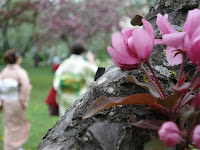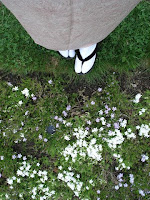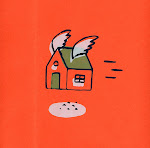 away from Japan. Another layer of irony: I learned traditional kitsuke from a Canadian woman, Maggie Hallem(photo: left), in her apartment in St-Henri, Montreal, Quebec, Canada. Our friendship grew steadily as did my passion for kimono. We developed an annual ritual of dressing up in our best spring kimono ensembles every May, and then shuffling down in our zori to attend the Hanami picnic held at the Montreal Botanical Gardens. There we ate our bento lunches and admired the blooming crab apple trees, dead-ringers for the Japanese ume and sakura, while garden visitors admired our kimonos and called us "geisha", much to the dismay of Maggie. (For those who are not familiar with this part of Japanese culture, an ordinary woman dressed in a kimono for any kind of occasion does not make her a 'geisha'. A geisha, or more properly called 'geiko', is a highly-skilled and highly-trained traditional Japanese entertainment artist, and what westerners normally see a geiko wearing, i.e. white make-up, opulent gold brocade obi, long, richly coloured kimono, lacquered wig, etc..., is her performance-costume. It's part of her job, but it's nothing at all like the everyday kimono she and all other Japanese women may wear as functional, traditional clothing. So the next time you see a woman wearing a kimono, don't call her 'geisha'! )
away from Japan. Another layer of irony: I learned traditional kitsuke from a Canadian woman, Maggie Hallem(photo: left), in her apartment in St-Henri, Montreal, Quebec, Canada. Our friendship grew steadily as did my passion for kimono. We developed an annual ritual of dressing up in our best spring kimono ensembles every May, and then shuffling down in our zori to attend the Hanami picnic held at the Montreal Botanical Gardens. There we ate our bento lunches and admired the blooming crab apple trees, dead-ringers for the Japanese ume and sakura, while garden visitors admired our kimonos and called us "geisha", much to the dismay of Maggie. (For those who are not familiar with this part of Japanese culture, an ordinary woman dressed in a kimono for any kind of occasion does not make her a 'geisha'. A geisha, or more properly called 'geiko', is a highly-skilled and highly-trained traditional Japanese entertainment artist, and what westerners normally see a geiko wearing, i.e. white make-up, opulent gold brocade obi, long, richly coloured kimono, lacquered wig, etc..., is her performance-costume. It's part of her job, but it's nothing at all like the everyday kimono she and all other Japanese women may wear as functional, traditional clothing. So the next time you see a woman wearing a kimono, don't call her 'geisha'! )My collection of kimono has grown, from the handful of vintage kimono and obi I
 bought at flea-markets in Japan, to over a dozen thanks to on-line second-hand kimono shops based in Osaka. Looking back on my first wave of purchases from flea-markets in Tokyo, I realized that I was somehow correctly choosing to buy all the necessary accessories for a full and functional kimono outfit, from kumi-himo, obi-jime, obiage and makura, to the right size of nagajyuban and tabi, even though I had no prior knowledge of what comprised a kimono outfit, and none of my Japanese friends could volunteer any guidance on the subject because they themselves knew so little about it. Luckily, the local bookstore's 'hobbies' section had a diverse and well-illustrated section on kimono kitsuke.
bought at flea-markets in Japan, to over a dozen thanks to on-line second-hand kimono shops based in Osaka. Looking back on my first wave of purchases from flea-markets in Tokyo, I realized that I was somehow correctly choosing to buy all the necessary accessories for a full and functional kimono outfit, from kumi-himo, obi-jime, obiage and makura, to the right size of nagajyuban and tabi, even though I had no prior knowledge of what comprised a kimono outfit, and none of my Japanese friends could volunteer any guidance on the subject because they themselves knew so little about it. Luckily, the local bookstore's 'hobbies' section had a diverse and well-illustrated section on kimono kitsuke.At one point, some kimono articles started finding me; I once found a perfectly new stiffener-board (for obi) just outside of a convenience-store after a hanabi festival in Tokyo. Some yukata-clad festival-goer, tipsy on too much beer, must have
 just fished that board out from between the layers of her han-haba obi and flung it onto the side of the road, in a fit of drunken discomfort and impatience. I have to admit that I myself have done just that a few times since I've started wearing kimono regularly, but I wasn't drunk. That board is uncomfortable, and something tells me that it's a 20th-centurey addition to the kimono outfit to further flatten the silhouette. On another lucky day in Tokyo, I came across a plastic bag tossed along with the non-burnable trash and it contained perfectly clean and entirely hand-made red fleece undergarments for kimono. Perfect for the bitter cold of Montreal winter.
just fished that board out from between the layers of her han-haba obi and flung it onto the side of the road, in a fit of drunken discomfort and impatience. I have to admit that I myself have done just that a few times since I've started wearing kimono regularly, but I wasn't drunk. That board is uncomfortable, and something tells me that it's a 20th-centurey addition to the kimono outfit to further flatten the silhouette. On another lucky day in Tokyo, I came across a plastic bag tossed along with the non-burnable trash and it contained perfectly clean and entirely hand-made red fleece undergarments for kimono. Perfect for the bitter cold of Montreal winter.Anyway, all this to say that I had somehow intuitively equipped myself with all the necessary accessories so that when the time came for me to learn kitsuke, which came about quite by accident, I had everything I needed to just go right ahead, and I hand-made all the accessories that I was missing: cotton under-shirt, suso and datejime.

Another curious detail in my adventure: I had gone about collecting very subdued and multi-purpose kimono and obi so that wearing them casually in public, especially in a north-American city like Montreal, was not that big of a deal, even though, at the time, I had only the haziest idea of what makes the difference between a furisode, a komon and a tomesode. I had been told about the sleeve-lengths viz-a-viz the age-appropriateness, but no one even hinted at the concept of iki, an approach of kistuke that idealized the subtlest co-ordination of color, seasonal pattern and accessory-details. Less is more, and says more.

Upon first encountering the world of kimono, I had naturally been drawn to the brighter-coloured kimono, though I never found myself attracted to the busy and over-the-top furisode and huomongi. A few moments of observation at most flea-markets in Tokyo showed me that tourists always went for the flashiest, brightest things they could find, and this made these articles 1.) more expensive, and 2.) unwearable because of how obvious they were, unless you were graduating from high-school, which I had already done nearly 2 decades ago. I concentrated instead on finding kimono with interesting weaves, dies and patterns that had a modern feeling but were clearly of vintage stock. The type of fabric was extremely important, I wouldn't go near any polyester obi or jyuban, let alone kimono; silk and wool had an infinitely more human feel to them, did not irritate my skin, and hung more elegantly. I tried to imagine
 wearing what I found as ordinary clothing and this made the deeper hues and graphically simple patterns more appealing and more realistic to me.
wearing what I found as ordinary clothing and this made the deeper hues and graphically simple patterns more appealing and more realistic to me.Of course, it's very easy to go to extremes when dealing with 'quieter and subtler', while the younger set were prescribed to wear very bright, acid colours for kimono, flower-patterns galore; the older ladies on the other hand, usually as a symbol of married-life, were expected to wear only the weakest and most sickly hues, the blandest conservative motifs barely visible on their obi. In the same way that the psychedelic armies of furisode-clad girls aggressively attracted immediate attention of the eye-popping halcyon patterns and colours, a sight at once arresting in its boldness but alarming in its efficiency in completely eclipsing the girl in the furisode to the point where it's practically impossible to distinguish one girl from the next. The older women, in contrast, appear to us as though ghosts of their former bright girl-selves, everything about their 'fading-fading-gone'-hued kimono making them seem to be disappearing before our very eyes. Yes, I'm exaggerating a little to make a point. I hope I didn't offend any furisode lovers or ladies who prefer to keep a low profile.
There is a happy medium, thankfully: what professional geisha wear during the day when they are not on-duty can be used as a good guide. There has to be a fine balance between colour and texture, and a hinted anticipation of a coming season shown through some unusual seasonal motif. The ensemble is never overbearing even when the colours for the kimono are strong, and never so subdued that it seems dead. Obidome for example, if used at all, should be of the most discrete design; a quiet complement of the total statement the wearer wants to make. Basically, the important thing to remember is that all the elements involved obey the 'Goldilocks' rule of 'just-right'.








Wow, I sometimes wore kimono abroad. So people thought me geisha!? OK it's not so bad. Because most of geisha are very pretty.
ReplyDeleteI agree you have quite chic and iki kimonos which fit beautiful flower gardens. Your obi is beautiful. Daruma is cute!
Today Tokyo sakura is full bloom. I will go out for dinner with sakura color obi and haori. Thanks for telling me there are such kimono lovers in Montreal. Let's enjoy kimono!
I live in Montreal and have been collecting kimono and practicing kitsuke a few years now, but aside from Collection Du Japon on Ste-Catherine, have never had much luck finding items here in the city (aside from tourist export claptrap or overpriced "antiques"). Do you know of any decent shops in the area who stock any? I'm currently in the market for a few iromuji, since I need more versatile but dressy kimono.
ReplyDeleteIf you're interested in chatting or just meeting up with a fellow kimono enthusiast in the city, please shoot me an email :)
diane (at) moonblossom (dot) net
Bonjour Madame,
ReplyDeleteJ aurais vraiment Besoin d'information Une je me cherche, je crois que le nom de Ses sandales Ce sont des zoris mais vous en portez vos pieds Dans Juste un peu plus haut et les chaussettes Qui vont avec savez-vous où je peux m , en proxénète à Montréal ou les environs.
merci beaucoup! et bonne journée
Joséeje me cherche, je crois que le nom de Ses sandales Ce sont des zoris ,mais vous en portez à vos pieds ,un peu plus haut et les chaussettes Qui vont avec savez-vous où je peux en trouver à Montréal ou les environs.
merci beaucoup! et bonne journée
Josée
je ne parle que français et j,ai traduit avec L'ordi en espérant que cela fonctionne bien .
Allo Josée, tellement désolé de répondre si tards! I wasn`t managing my blog in a while. p
ReplyDeleteProbably you will not read this, but for those who will read the comments and ask a similar question.
Q. Where to buy TABI(socks), GETA(wooden sandals) and ZOURI(vinyl sandals) in Montreal?
A. Uchiyama tea shop: 460 Rue Sainte-Catherine Ouest, locale 423, Montreal, QC H3B 1A7(514) 393-1342